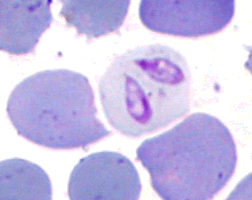Domain Eukaryota | Family Babesiidae Rank Species Higher classification Babesiidae | |
 | ||
Similar Babesia, Rhipicephalus sanguineus, Ehrlichia canis, Ornate cow tick, Brucella canis | ||
Babesia canis
Babesia canis is a parasite which infects red blood cells and can lead to anemia. This is a species that falls under the overarching genus Babesia. Babesia canis is transmitted by the brown dog tick (Rhipicephalus sanguineus) and is one of the most common piroplasm infections. The brown dog tick is adapted to warmer climate, therefore most infections come from the southern and southeastern United States and from California, especially in shelters and greyhound kennels. Babesia canis is also predominately in Europe and transmitted by Dermacentor ticks with an alarming increase in infections due to people traveling with their pets.
Contents
Babesia canis
Life cycle
A tick carrying B. canis sporozoites attaches to a dog, and feeds on its blood, releasing many sporozoites into the dog's bloodstream. Each sporozoite attaches to a red blood cell, and moves inside the cell. Once inside the red blood cell, the sporozoite loses its outer coating. It divides, becoming a new form, known as a merozoite. Inside the tick, the merozoite undergoes sexual reproduction (gamogony), which is followed by asexual reproduction, resulting in many sporozoites. These are found in the tick salivary glands, and they move from there into the next dog that the tick feeds from. Pregnant dogs can transmit Babesia canis to their unborn puppies, therefore it is recommended that infected females should not be bred.
Symptoms, diagnosis, and treatment
The clinical signs of Babesia canis are lethargy, weakness, vomiting, anorexia, fever, pale mucous membranes, and dark discoloration of the urine. There may be other symptoms including neurological and respiratory signs.
Babesia canis is not easy to diagnose on a blood smear since the chance of finding the parasite is low, due to its small size. Taking blood from a capillary source (such as a fresh cut) rather than from a blood vessel increases the chances of finding the organism. Polymerase chain reaction (PCR) testing is a more accurate diagnostic method.
Babesia canis infection in dogs usually responds to treatment with imidocarb dipropionate, although the infection may not be eliminated and dogs can become permanent carriers of Babesia. In dogs infected with Babesia, splenectomy (removal of the spleen) or any immunosuppressive drug should be avoided, otherwise signs of babesiosis may recur.
Prevention
Vaccines are not available in North America to prevent Babesia canis, but in France there is a vaccine available although it only seems effective against certain strains. The best prevention is tick control, or prompt removal of ticks from the dog. The spread of B. canis via blood donation can be prevented by screening of potential donor-dogs for Babesia canis infection prior to their donation.
